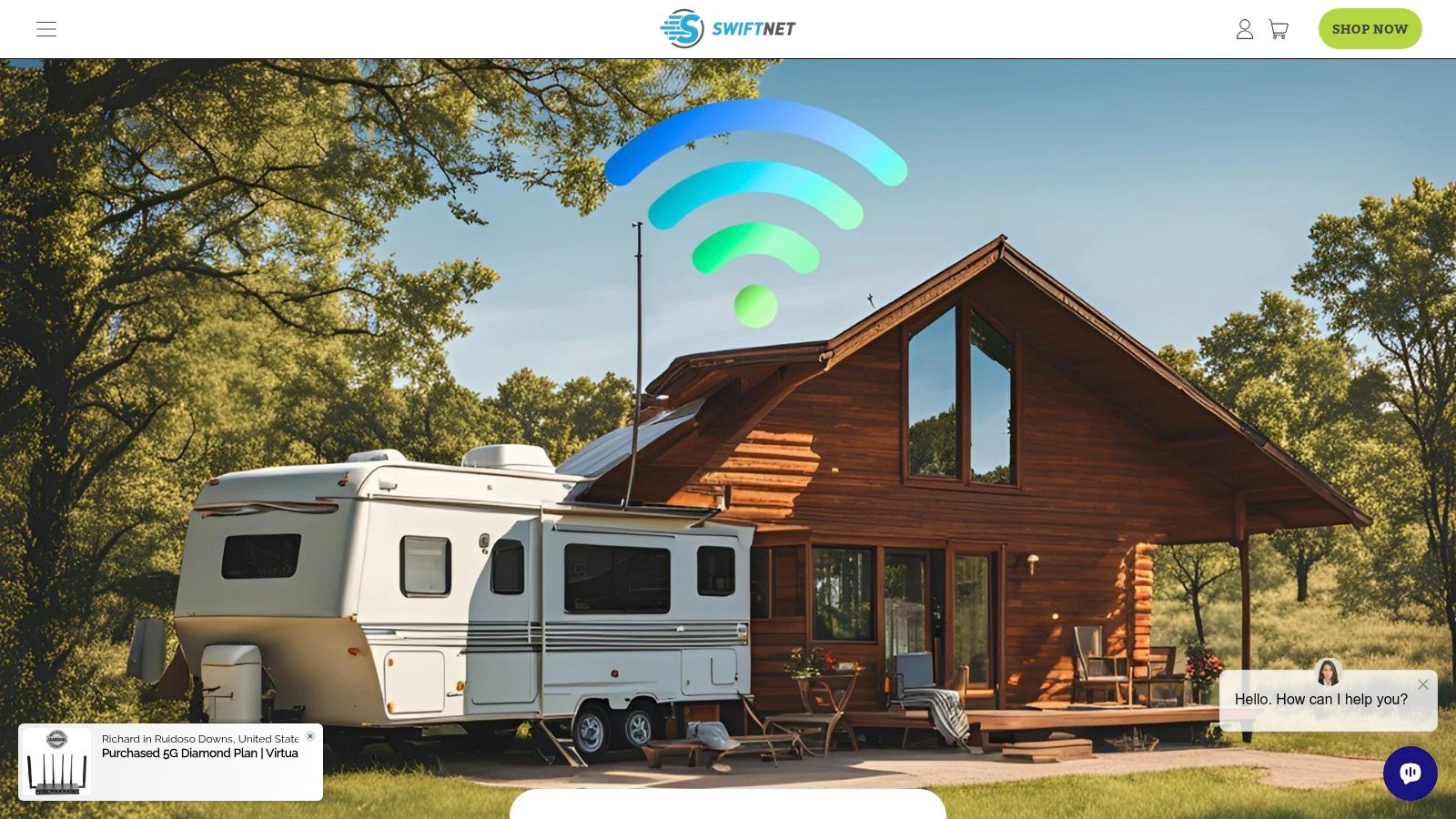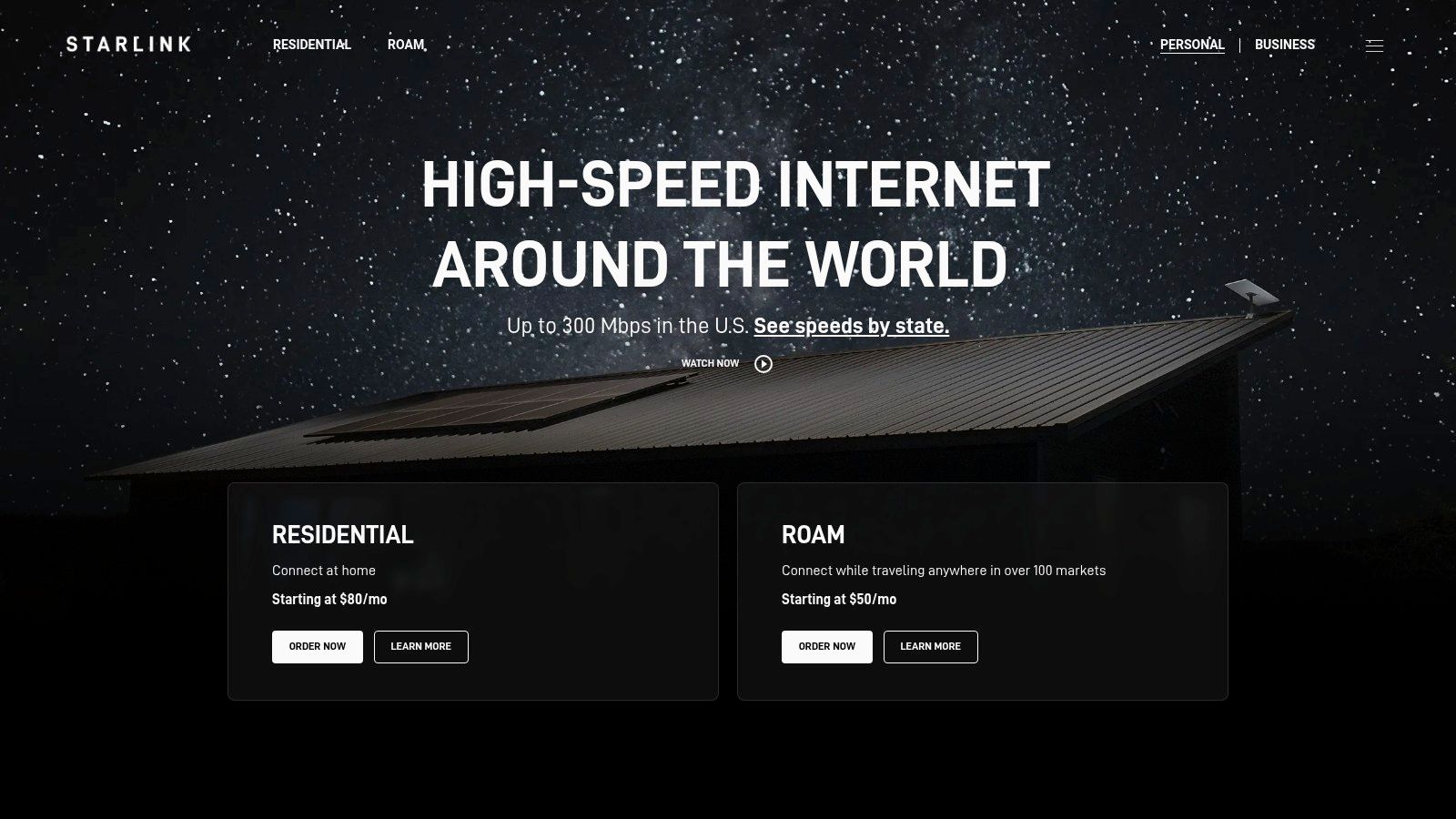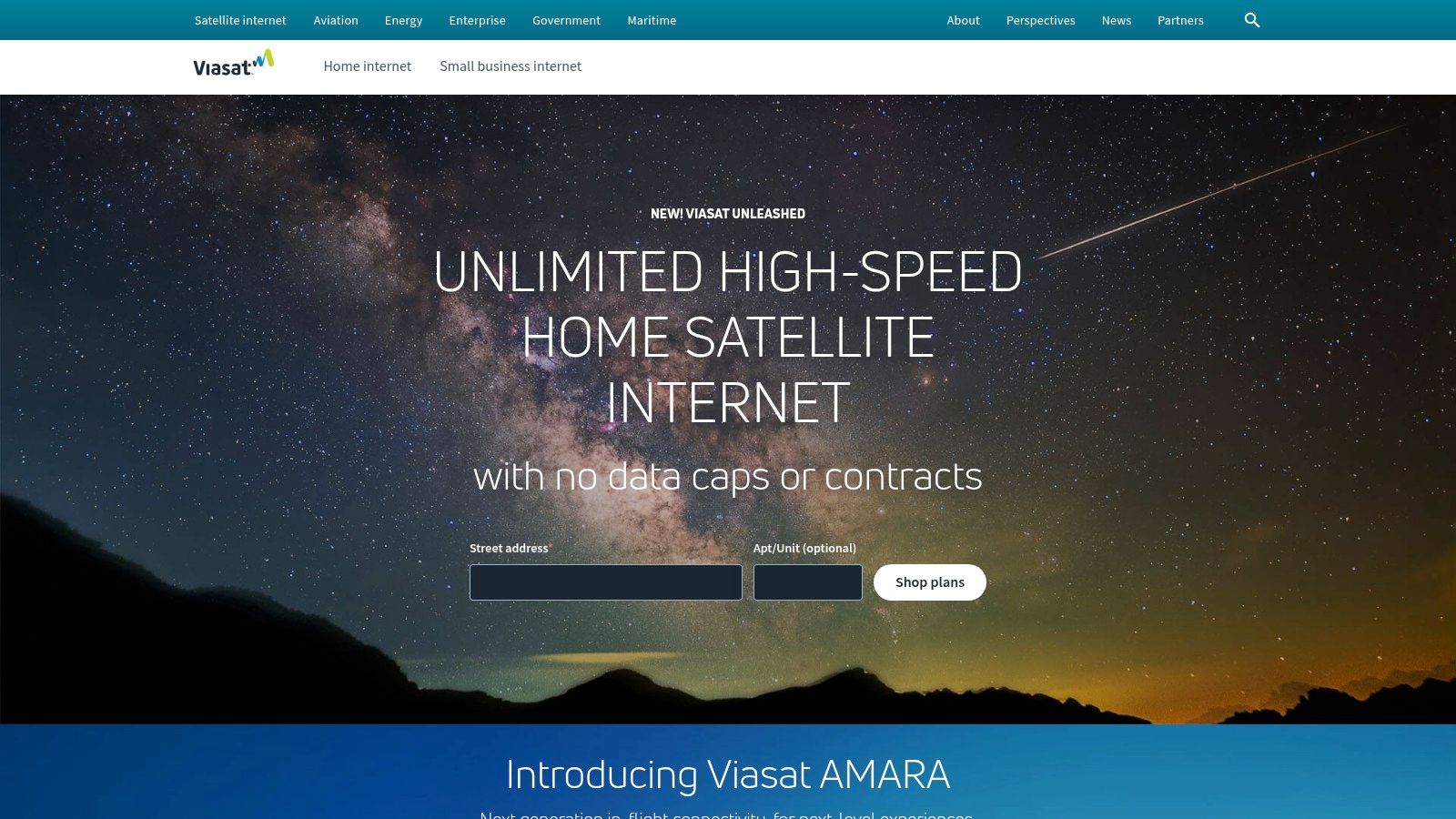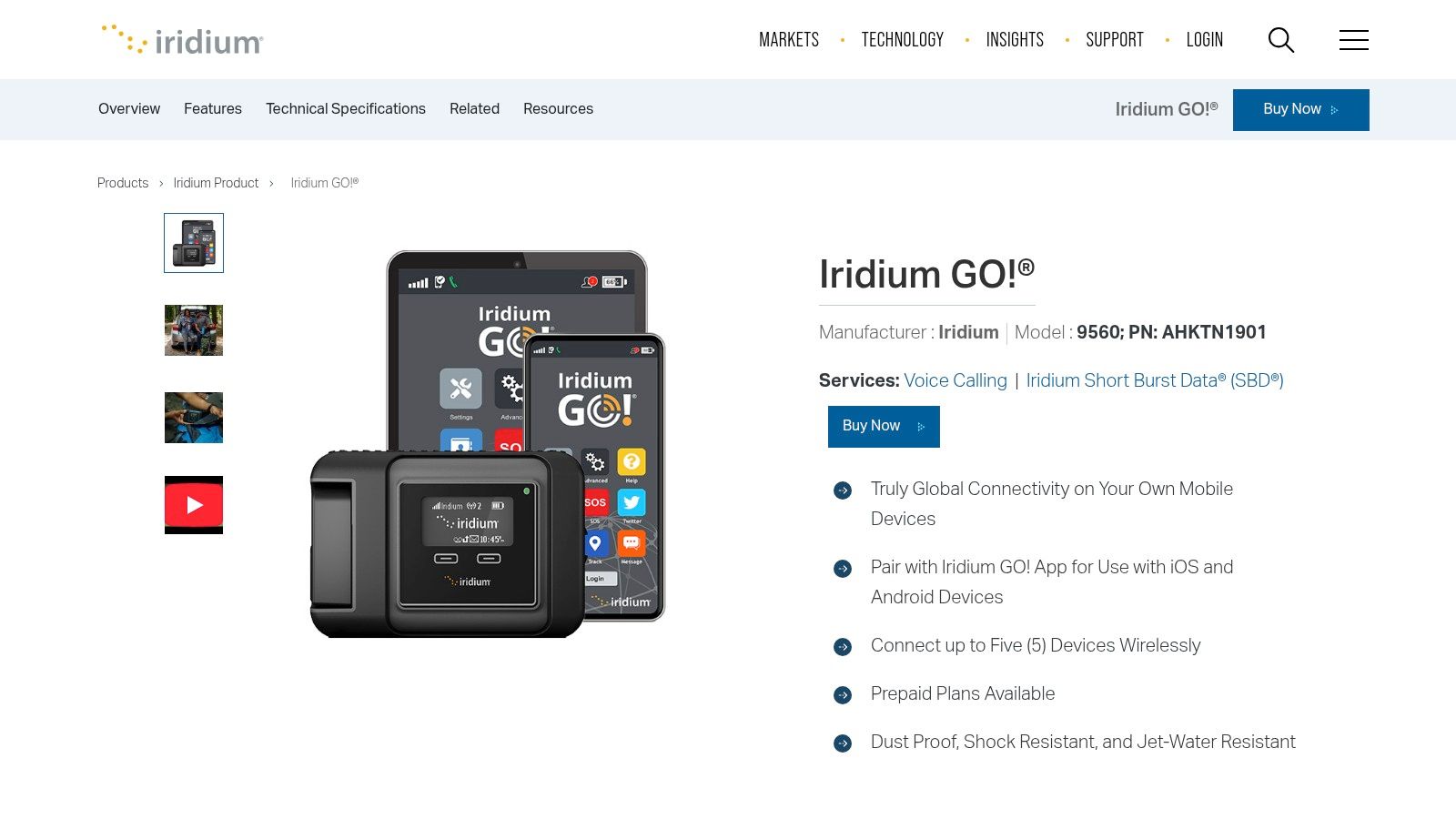

· Por James
2025's Best Off Grid Internet Options
Staying Connected Beyond the Grid
Need reliable internet access off the grid? This list explores the seven best off grid internet options for 2025. Discover the pros and cons of each, from SwiftNet Wifi to satellite and cellular solutions, to find the perfect connection for your remote work, RV travels, or rural property. We'll focus on solutions comparable to our top pick, SwiftNet Wifi, briefly touching on alternatives so you can make an informed decision and find the best off grid internet solution for your needs.
1. SwiftNet Wifi
For those seeking reliable off-grid internet access, especially RV travelers and residents of rural areas lacking fiber optic infrastructure, SwiftNet Wifi emerges as a promising solution. This provider specializes in delivering high-speed 5G internet service specifically designed to cater to the needs of those beyond the reach of traditional wired connections. This makes it a strong contender for the best off-grid internet option, particularly for those who require robust connectivity on the move or in remote locations.

SwiftNet Wifi prioritizes providing high-speed connectivity where other options falter. Their focus on 5G technology allows them to leverage the latest advancements in wireless communication to deliver faster speeds and greater bandwidth compared to older 4G LTE solutions. While some competitors may offer similar services, SwiftNet Wifi's dedication to serving rural communities and mobile lifestyles sets them apart. Their specialized focus allows them to tailor their services and support to better meet the specific challenges of off-grid internet access.
While detailed pricing and specific technical requirements aren't readily available on their website, the emphasis on 5G suggests that users will need a compatible 5G device or modem to access the service. For RV travelers, this translates to convenient internet access wherever their travels take them, enabling remote work, streaming entertainment, and staying connected with family and friends. For residents in rural areas, SwiftNet Wifi offers a viable alternative to satellite internet or limited DSL options, potentially providing significantly faster speeds and more reliable connections.
For those considering SwiftNet Wifi, it's recommended to visit their website (https://swiftnetwifi.com) to inquire about specific plans, pricing, data limits, and coverage availability in your area. This will help you determine the suitability of their service for your individual needs and compare it to any other potential alternatives. Information regarding setup is also likely available through their customer service channels, providing potential users with guidance on the installation and configuration process. SwiftNet Wifi's focus on the unique demands of off-grid connectivity makes it a valuable option to explore for anyone struggling to find reliable internet access outside of traditional service areas.
2. Starlink: Best Off Grid Internet for Remote Locations
For those seeking the best off grid internet, Starlink is a compelling option that has revolutionized connectivity in remote areas. Developed by SpaceX, Starlink utilizes a constellation of low Earth orbit (LEO) satellites to deliver high-speed internet to places traditional providers can't reach. This makes it a game-changer for RV travelers, rural homeowners, and remote workers seeking reliable internet access. It offers a significant upgrade over traditional satellite internet, suffering from far less latency, making activities like video conferencing and online gaming actually feasible. For those tired of struggling with slow or nonexistent internet connections, Starlink offers a viable solution for consistent, high-quality connectivity.

Starlink’s self-aligning dish requires a clear view of the sky to connect with the LEO satellite network. Speeds typically range from 50-200 Mbps download, significantly faster than older satellite internet technologies and often rivaling wired connections. This speed, combined with low latency (20-40ms), makes it suitable for bandwidth-intensive tasks like streaming, video calls, and online gaming. The portability of Starlink's equipment is a major advantage for those on the move, including RV owners and travelers who work online remotely. Learn more about Starlink and its growing capabilities. While some competitors offer mobile internet solutions, they often rely on cellular networks which can be unreliable or nonexistent in truly off-grid locations. Starlink's satellite-based approach sidesteps these limitations, providing dependable connectivity almost anywhere with a clear view of the sky.
The Starlink kit comes with a self-aligning dish, router, and all necessary cabling. Setup is designed to be user-friendly, allowing for quick self-installation. The system generally performs well in most weather conditions, although heavy snow or dense cloud cover can occasionally impact performance. The cost of the hardware is currently $599+, with monthly subscription fees ranging from $110-$150 depending on the chosen plan. Most plans offer unlimited data, unlike some competitors who impose restrictive data caps, making Starlink a more attractive option for high-bandwidth users. The system does require a significant amount of power (50-75W continuously), an important consideration for off-grid power management.
Pros:
- Works almost anywhere with a clear view of the sky
- Much faster than traditional satellite internet
- Simple self-installation
- Reliable in most weather conditions
- No data caps on most plans
Cons:
- Relatively expensive hardware ($599+)
- Monthly subscription cost ($110-$150/month)
- Requires significant power (50-75W continuously)
- Occasional outages can occur
For those seeking the best off grid internet solution for remote work, RV living, or simply staying connected in a rural area, Starlink offers a compelling combination of speed, reliability, and portability. While the initial cost is an investment, the ability to access high-speed internet in previously unconnected locations makes it a valuable tool for many. For those locations where Starlink might not be the best fit, exploring other options within a curated list of the best off grid internet providers can help identify the optimal solution for individual needs. Remember to check out the official Starlink website for the most up-to-date information: https://www.starlink.com
3. Viasat
For those seeking reliable off-grid internet access across North America, Viasat emerges as a strong contender. Leveraging geostationary satellites, Viasat delivers internet connectivity to even the most remote locations, making it a practical solution for RV travelers, rural homeowners, and remote workers seeking the best off-grid internet. Its extensive coverage and established infrastructure make it a dependable choice when other options falter. Viasat's speeds are generally sufficient for common online activities like browsing, email, and streaming, making it suitable for both work and leisure.

Viasat offers various plans catering to different needs and budgets, with download speeds reaching up to 100 Mbps on premium plans. A key advantage of Viasat is its data prioritization system. Instead of imposing hard data caps, Viasat prioritizes data usage. After you've used a certain amount of high-priority data, your speeds may be reduced, but you won't be cut off completely. This is a significant benefit for those who rely heavily on internet access in off-grid locations. The inclusion of professional installation and a built-in Wi-Fi router further simplifies the setup process. This makes it particularly appealing for users who may not be tech-savvy and prefer a hassle-free experience.
Viasat's extensive reach across North America makes it a viable option for those in extremely remote areas. While newer Low Earth Orbit (LEO) satellite internet services boast lower latency, Viasat's well-established infrastructure and broad coverage give it a reliability edge, particularly in areas where newer services might not yet be available.
Pros:
- Established service with proven reliability: Viasat has a long track record of providing reliable internet service in off-grid areas.
- No hard data limits (soft caps with prioritization): Continue to access the internet even after exceeding your priority data allowance.
- Widely available even in extremely remote areas: Viasat's coverage extends to many areas where other internet options are unavailable.
- Multiple plan options for different needs: Choose the plan that best fits your data usage and speed requirements.
Cons:
- Higher latency (600-800ms) than newer satellite services: This can impact activities sensitive to lag, such as online gaming.
- Speed throttling after priority data is used: While you won't lose access, your speeds may be reduced.
- Requires professional installation: While this ensures proper setup, it can add to the initial cost.
- 24-month contract typically required: This requires a longer-term commitment.
Website: https://www.viasat.com
While other satellite internet providers exist, Viasat’s established infrastructure and widespread availability, especially in remote North America, make it a compelling choice for many off-grid users. Its "no hard data cap" approach also offers greater peace of mind compared to providers with strict data limits. This makes it a valuable tool for staying connected for work, entertainment, and communication, even in the most remote corners of the continent.
4. HughesNet
For those seeking reliable off-grid internet access across the continental US, HughesNet emerges as a viable solution. Leveraging geostationary satellite technology, HughesNet offers consistent service, making it suitable for basic internet needs in remote areas where other options like fiber optic internet are unavailable. This makes it a solid contender for the best off grid internet, particularly for individuals working remotely from rural locations, RV travelers, and those living off-the-grid who require a consistent connection.

HughesNet shines with its 100% coverage across the continental United States. This widespread availability is a major advantage for RV owners and travelers who need internet access on the go, regardless of their location. All HughesNet plans offer 25 Mbps download speeds, which while not blazing fast, are sufficient for everyday tasks like email, web browsing, and light video streaming. Their clearly defined data allowances, ranging from 15GB to 75GB per month, along with the "Bonus Zone" (free data usage from 2am-8am), provide users with predictable usage patterns and help manage costs. The built-in Wi-Fi capabilities further simplify setup and allow multiple devices to connect easily.
A major benefit of HughesNet is its consistent performance regardless of location. This is particularly valuable for those in remote areas where terrestrial internet options might be unreliable or non-existent. The transparent pricing and data allowances eliminate surprises, and the equipment costs are generally lower than some competitors. While some competitors may throttle speeds drastically after exceeding data limits, HughesNet simply reduces speeds, allowing continued, albeit slower, connectivity.
However, it's important to be aware of the limitations. HughesNet suffers from high latency (around 600ms+), which can impact real-time applications like online gaming and video conferencing. The 25 Mbps download speed is comparatively slower than other off-grid internet alternatives (although availability is a key differentiator here). Additionally, HughesNet requires a two-year contract, and exceeding data limits incurs additional charges.
For those living in rural areas or traveling in an RV, setting up HughesNet is relatively straightforward. A technician will install the satellite dish and modem, ensuring optimal signal reception. Users should carefully consider their data needs and choose a plan accordingly. Utilizing the "Bonus Zone" for data-intensive tasks can help maximize usage within the monthly allowance.
While there are other satellite internet providers available, HughesNet stands out due to its extensive coverage and transparent data plans. For users prioritizing consistent connectivity and predictable costs, HughesNet offers a practical solution for their off-grid internet needs. For detailed pricing and plan options, visit their website: https://www.hughesnet.com
5. 4G/LTE Cellular Internet with WeBoost
For those seeking the best off-grid internet, a 4G/LTE cellular connection amplified by WeBoost offers a powerful and flexible solution. This setup combines the convenience of existing cellular data plans with WeBoost's signal boosting technology, effectively extending the reach of 4G/LTE networks into areas where service would typically be spotty or nonexistent. This makes it an ideal option for RV travelers, rural residents, remote workers, and anyone else seeking reliable internet access beyond the reach of traditional wired connections.

WeBoost systems work by capturing existing cellular signals, amplifying them up to 32x, and then rebroadcasting the boosted signal to your devices. This significantly expands the usable range of cell towers, enabling connectivity even in remote locations. The system comprises a cellular data plan from your preferred carrier (Verizon, AT&T, T-Mobile, etc.), a WeBoost signal amplifier, and appropriate antennas for both receiving and transmitting the signal. WeBoost offers a range of models designed for various applications, including home use, vehicle mounting, and portable setups, catering to both stationary and mobile off-grid internet needs. Pricing for WeBoost equipment typically ranges from $300 to $1000 depending on the specific model and its capabilities. Learn more about 4G/LTE Cellular Internet with WeBoost.
One of the major advantages of this approach is its reliance on existing cellular infrastructure. This eliminates the need for specialized and often costly satellite internet equipment and subscriptions. It also typically results in lower latency compared to satellite internet, making it more suitable for activities like video conferencing and online gaming. The one-time equipment purchase also means there are no ongoing equipment rental fees, only the cost of your chosen cellular data plan.
However, the effectiveness of a WeBoost system hinges on the proximity and availability of cellular towers. While it can significantly boost weak signals, it requires some existing signal to amplify. Completely dead zones will remain unusable. Furthermore, cellular data plans may have data caps or throttling limitations, which could impact usage in bandwidth-intensive applications. It's crucial to carefully research data plans and choose one that aligns with your anticipated usage. While other signal boosters exist on the market, WeBoost's reputation for quality and performance makes it a reliable choice for boosting your off-grid internet experience.
Setting up a WeBoost system involves installing the amplifier unit and strategically placing the antennas. The outside antenna needs a clear line of sight towards the nearest cell tower for optimal performance. The inside antenna then distributes the boosted signal within your home, vehicle, or designated area. Some models may require professional installation, while others are designed for easy DIY setup. Choosing the right model for your specific needs and location is paramount for a successful off-grid internet experience.
6. Nomad Internet
Nomad Internet stands out as a prominent player in the best off grid internet landscape, catering specifically to the needs of those beyond the reach of traditional broadband. This includes RV travelers, rural residents, and anyone who needs reliable internet access outside of major metropolitan areas. They achieve this by leveraging 4G/LTE and 5G cellular technology, aggregating service from major carriers and offering specialized equipment designed to maximize signal capture in remote locations. Their focus on unlimited data plans without throttling is a key differentiator, making them a compelling option for those who rely heavily on consistent internet access.

Nomad Internet understands the unique challenges of staying connected while off-grid. Their plans are designed to provide true unlimited data, meaning you can stream, work, and browse without worrying about data caps or speed throttling, a common frustration with many other providers. This makes them particularly appealing to digital nomads, remote workers, and RV enthusiasts who require consistent, high-bandwidth internet access for their work and leisure activities. While some competitors offer "unlimited" plans, they often come with hidden throttling clauses after a certain usage threshold. Nomad Internet aims to provide a truly uncapped experience. Their equipment, which includes high-gain antennas and routers, are specifically chosen to optimize signal strength and stability in areas with weak cellular reception. This plug-and-play equipment is pre-configured for ease of use, ensuring a quick and straightforward setup process. The flexibility to pause your service when not needed is another attractive feature, particularly beneficial for those who travel seasonally or only require internet access for part of the year.
Nomad Internet's plans range from $129-$179/month, representing a higher cost than conventional fixed-line internet. However, this premium reflects the specialized service and equipment required to deliver reliable connectivity in areas underserved by traditional infrastructure. The cost is often justified by the value of staying connected in places where other options are unavailable or unreliable. Performance can vary based on location and proximity to cell towers, a factor inherent in any cellular-based internet solution. You'll need to purchase or rent their equipment, which adds to the initial cost. Finally, while Nomad Internet strives to provide consistent service, they may prioritize traffic during periods of network congestion. For more details on their offerings, Learn more about Nomad Internet. For many users, the ability to have consistent, unlimited data in remote locations outweighs these considerations, establishing Nomad Internet as a viable option for the best off grid internet.
7. Iridium GO! Satellite Hotspot
When it comes to finding the best off grid internet, truly global coverage is often the holy grail. If you need connectivity literally anywhere – from the remote reaches of the Sahara to the vast expanse of the Pacific Ocean – the Iridium GO! Satellite Hotspot deserves a place in your toolkit. This portable device uses the Iridium satellite constellation to create a Wi-Fi connection where no terrestrial networks dare to venture, making it a reliable choice for essential communications in the most extreme off-grid situations.

Unlike some broadband-focused satellite internet solutions, the Iridium GO! prioritizes essential communication over high-bandwidth activities. Think voice calls, text messages, basic email access (through a dedicated app), and weather updates – crucial lifelines when you're miles from civilization. This focus makes it ideal for emergency situations, keeping you connected when it matters most. RV travelers venturing far off the beaten path, remote workers needing a backup communication plan, and anyone prioritizing safety in truly off-grid locations will appreciate this lifeline.
The Iridium GO! connects to your smartphone via a dedicated app, transforming your device into a satellite communication hub. Its battery-powered design adds to its portability, allowing you to stay connected even when power sources are scarce. The durable, weather-resistant construction ensures it can withstand the rigors of challenging environments.
The Iridium GO! typically costs between $700 and $1000 for the device itself. Data plans range from $50 to $150 per month, offering limited data allowances. This cost reflects the truly global nature of the service and the infrastructure required to maintain it. The data speeds are relatively slow, around 2.4 Kbps. This is enough for essential communication, but not suitable for streaming videos, browsing the web extensively, or other high-bandwidth activities.
Key Features and Benefits:
- Truly global coverage: Works literally anywhere on Earth, including oceans and poles.
- Portable and Battery-Powered: Easy to carry and use on the go.
- Essential Communications: Reliable voice calls, text messages, basic email, and weather updates.
- SOS Emergency Services: Built-in emergency functionality for added safety.
- Durable and Weather-Resistant: Designed to withstand harsh environments.
Pros:
- Unparalleled global coverage.
- Highly portable and battery-powered.
- Reliable for emergency communication.
- Rugged and weather-resistant build.
Cons:
- Very slow data speeds (2.4 Kbps).
- Expensive equipment and data plans.
- Limited to basic communication functions.
Implementation Tip: Before venturing off-grid, download the Iridium GO! app and familiarize yourself with its features. Pre-program important contacts and test the device to ensure a smooth experience when you need it most.
The Iridium GO! occupies a unique niche in the off-grid internet landscape. While not suitable for everyday internet use due to its speed and cost, its unparalleled global coverage and focus on essential communication make it a critical tool for specific audiences and use cases. When venturing into areas where other connectivity options simply don't exist, the Iridium GO! provides a crucial link to the outside world, offering peace of mind and a vital safety net in emergency situations. For true off-grid adventures where reliability and safety are paramount, the Iridium GO! offers unparalleled peace of mind. You won't find this level of global, dependable connectivity with alternatives. Check out their website for more details: https://www.iridium.com/products/iridium-go/
7-Point Off-Grid Internet Comparison
| Provider | Core Features ✨ | User Experience ★ | Value Proposition 💰 | Target Audience 👥 | Unique Selling Points ✨ |
|---|---|---|---|---|---|
| 🏆 SwiftNet Wifi | 5G high speed; rural & RV focus | Simple, reliable | Competitive pricing | Rural areas & RV travelers | Latest tech; recommended |
| Starlink | LEO satellites; low latency; portable dish | Reliable; self-install | Higher hardware & subscription cost | Rural, remote, RV users | Self-aligning dish; broad sky coverage |
| Viasat | GEO satellites; wide NA coverage; multiple plans | Proven reliability; higher latency | Varied plans; installation fee | Remote communities | Established service; professional setup |
| HughesNet | GEO satellites; defined data allowances; Bonus Zone | Consistent performance; basic speeds | Transparent pricing; budget friendly | US off-grid residents | Bonus free data hours; clear limits |
| 4G/LTE + WeBoost | Signal booster; uses cellular networks | Low latency; flexible mobility | One-time equipment cost + data plan | Remote users near towers | Amplifies signal up to 32x |
| Nomad Internet | Unlimited data; 4G/LTE & 5G aggregation | Plug-and-play; dependable | Higher monthly rates | RVers; rural residents; off-grid users | True unlimited data; no throttling |
| Iridium GO! Hotspot | Portable satellite hotspot; global coverage | Rugged; emergency-ready | Expensive equipment and data plans | Extreme remote; emergency users | SOS built-in; works anywhere on Earth |
Choosing Your Best Connection
Finding the best off grid internet requires careful consideration of several factors. This article explored a range of options, from satellite internet providers like Starlink, Viasat, and HughesNet to cellular-based solutions such as 4G/LTE with WeBoost and Nomad Internet, and even the highly portable Iridium GO! for truly global coverage. We also highlighted SwiftNet Wifi, a service focused on delivering high-speed internet to rural areas. While some competitors may offer similar services, SwiftNet Wifi prioritizes reliable connectivity and consistent performance, crucial factors for off-grid living and remote work.
Key takeaways when choosing your off-grid internet solution include understanding your data needs, considering the terrain and typical weather conditions in your area, and balancing performance with affordability. For users in motion, like RV travelers, portability and ease of setup are paramount. If your travels or lifestyle frequently take you beyond the reach of terrestrial towers, satellite internet may be your only viable option. However, factors like latency and data caps can significantly impact the user experience, so careful research is crucial. Some providers offer unlimited data but throttle speeds after a certain threshold, affecting activities like video conferencing and streaming.
For those in rural areas or seeking a reliable connection for remote work, prioritizing a consistent and robust connection is paramount. While some options may offer enticing introductory pricing, be sure to consider long-term costs and contract obligations.
Ready to experience the freedom of reliable, high-speed internet wherever your adventures take you? SwiftNet Wifi offers tailored solutions for rural connectivity, empowering you to work, stream, and stay connected off the grid. Explore how SwiftNet Wifi can keep you seamlessly online, even in the most remote locations, by visiting SwiftNet Wifi.

